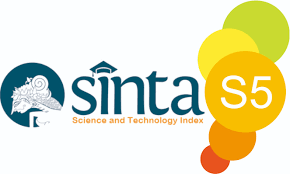Penelitian Berkelanjutan Dalam Pariwisata Berbasis Alam: Analisis Bibliometrik Dan Visualisasi
 Abstract views: 130
,
Abstract views: 130
,
 pdf downloads: 58
pdf downloads: 58
Abstract
Sustainability, and specifically the need to understand the nature and liminature based tourism of growth, has developed into an important policy issue in tourism literature in the last decade. The objective of the present study is to use a bibliometric approach to review the relevant literature. Bibliometric indicators, such as citations, are used to identify the field structure and the VOSviewer software is used to map the main trends in this area. The bibliometric analysis process comprises three phases: (i) Search Criteria and Source Identification, (ii) software and data extraction, and (iii) data analysis and interpretation.The resulnature based tourism show nature based tourism in full growth as a scientific discipline, thanks to the contribution of various authors, institutions, journals, and related topics that confirm the importance of this field of study. Additionally, bibliometric maps lead to an understanding of the intellectual structure of the subject, in which keyword co-occurrence analysis shows six main themes, ranging from ‘Ecosytem Services’ to ‘Sustainable Tourism’. this, combined with maps of co-citation, broadly exhibinature based tourism this structure and development, showing areas of current interest and potential development, thus offering the latest knowledge nature based tourism research worldwide.
Downloads
References
(2) Della Corte, V., Del Gaudio, G., Sepe, F., & Sciarelli, F. (2019). Sustainable tourism in the open innovation realm: A bibliometric analysis. Sustainability (Switzerland), 11(21), 1–18. https://doi.org/10.3390/su11216114
(3) Gu, X., Hunt, C. A., Lengieza, M. L., Niu, L., Wu, H., Wang, Y., & Jia, X. (2021). Evaluating residents’ perceptions of nature-based tourism with a factor-cluster approach. Sustainability (Switzerland), 13(1), 1–19. https://doi.org/10.3390/su13010199
(4) Long, C., Lu, S., Chang, J., Zhu, J., & Chen, L. (2022). Tourism Environmental Carrying Capacity Review, Hotspot, Issue, and Prospect. International Journal of Environmental Research and Public Health, 19(24). https://doi.org/10.3390/ijerph192416663
(5) Lopes, E., Araújo-Vila, N., Perinotto, A. R. C., & Cardoso, L. (2022). Tourism and Land Planning in Natural Spaces: Bibliometric Approach to the Structure of Scientific Concepts. Land, 11(11), 1930. https://doi.org/10.3390/land11111930
(6) Niñerola, A., Sánchez-Rebull, M. V., & Hernández-Lara, A. B. (2019). Tourism research on sustainability: A bibliometric analysis. Sustainability (Switzerland), 11(5), 1–17. https://doi.org/10.3390/su11051377
(7) Sánchez-Cañizares, S. M., Castillo-Canalejo, A. M., & Cabeza-Ramírez, L. J. (2018). Sustainable tourism in sensitive areas: Bibliometric characterisation and content analysis of specialised literature. Sustainability (Switzerland), 10(5). https://doi.org/10.3390/su10051525
Copyright (c) 2023 sukron romadhona

This work is licensed under a Creative Commons Attribution-ShareAlike 4.0 International License.
Authors who publish with this journal agree to the following terms:
- The author (s) keeps copyright on any article.
- The author grants the journal, right of first publication with the work simultaneously licensed under a Creative Commons Attribution License that allows others to share the work with an acknowledgement of the work’s authorship and initial publication in this journal.
- Authors can enter separate, additional contractual arrangements for the non-exclusive distribution of the journal’s published version of the work (e.g., post it to an institutional repository or publish it in a book), with an acknowledgement of its initial publication in this journal.
- Authors are permitted and encouraged to post their work online (e.g., in institutional repositories or on their website) prior to and during the submission process, as it can lead to productive exchanges, as well as earlier and greater citation of published work.
- We distributed the article, and any associated published material under the Creative Commons Attribution-Share alike 4.0 International License




